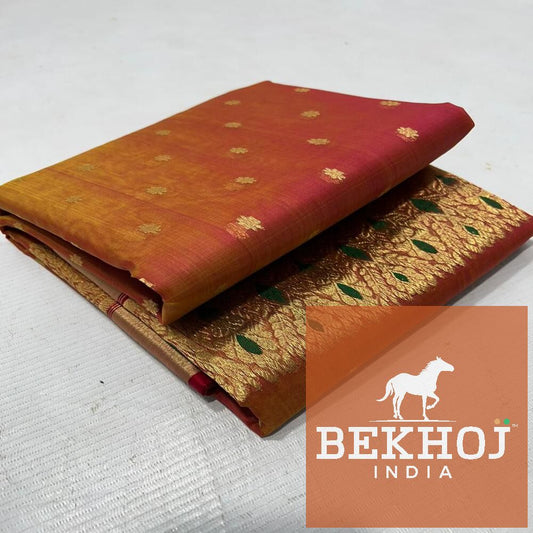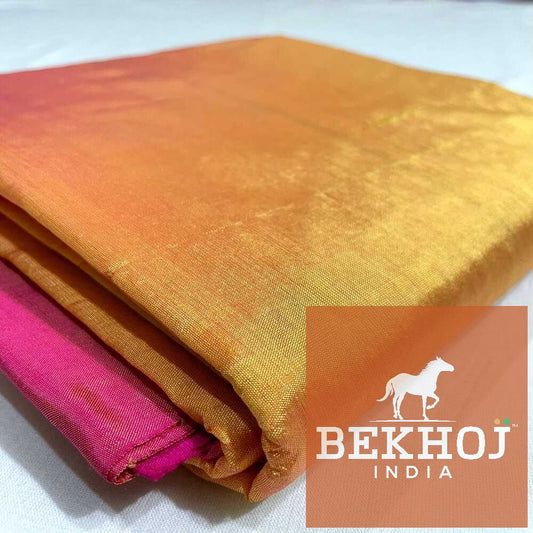-
Katan Chanderi Saree
Regular price ₹ 10,850Sale price ₹ 10,850 Regular priceUnit price per -
Black-Pink Pattu Silk
Regular price ₹ 10,850Sale price ₹ 10,850 Regular priceUnit price per -
Purple Pattu Silk
Regular price ₹ 10,850Sale price ₹ 10,850 Regular priceUnit price per -
Celebrity Exclusive -Green Chanderi Pattu Silk
Regular price ₹ 11,850Sale price ₹ 11,850 Regular priceUnit price per -
Chanderi Pattu Silk
Regular price ₹ 9,850Sale price ₹ 9,850 Regular priceUnit price per -
Handwoven Chanderi Katan Silk
Regular price ₹ 10,350Sale price ₹ 10,350 Regular priceUnit price per -
Handwoven Chanderi Katan Silk with beatiful Nakshi Border
Regular price ₹ 11,350Sale price ₹ 11,350 Regular priceUnit price per -
Handwoven Chanderi Katan Silk
Regular price ₹ 12,350Sale price ₹ 12,350 Regular priceUnit price per -

 Sold out
Sold outHandwoven Chanderi Katan Silk
Regular price ₹ 12,350Sale price ₹ 12,350 Regular priceUnit price perSold out -
Chanderi Cotton Silk
Regular price ₹ 5,500Sale price ₹ 5,500 Regular priceUnit price per -
Chanderi Pattu Silk with Fancy Design
Regular price ₹ 9,650Sale price ₹ 9,650 Regular priceUnit price per₹ 8,000 -
Beautiful Pure Handwoven office wear traditional chanderi Bana Silk saree
Regular price ₹ 2,500Sale price ₹ 2,500 Regular priceUnit price perSale -
Celebrity Exclusive Pattu Silk
Regular price ₹ 16,650Sale price ₹ 16,650 Regular priceUnit price per₹ 8,000 -

 Sale
SaleChanderi Katan Silk
Regular price ₹ 6,950Sale price ₹ 6,950 Regular priceUnit price per₹ 8,000Sale -
Chanderi Half Tissue Gold, silver, Coffee Zari
Regular price ₹ 9,850Sale price ₹ 9,850 Regular priceUnit price per -
Chanderi Half Tissue Red Golden Zari
Regular price ₹ 9,500Sale price ₹ 9,500 Regular priceUnit price per -
Unique Handwoven Border Chanderi Pattu Silk
Regular price ₹ 22,800Sale price ₹ 22,800 Regular priceUnit price per -
Chanderi Pattu Silk- VasuBaras Special
Regular price ₹ 22,800Sale price ₹ 22,800 Regular priceUnit price per -
Handwoven Chanderi Katan Silk Nakshi Border
Regular price ₹ 12,800Sale price ₹ 12,800 Regular priceUnit price per -

 Sold out
Sold outChanderi Half Tissue Golden Zari
Regular price ₹ 11,500Sale price ₹ 11,500 Regular priceUnit price perSold out -
Shridevi Chanderi Katan Silk
Regular price ₹ 14,250Sale price ₹ 14,250 Regular priceUnit price per₹ 8,000 -
Exclusive Golden Silver Black Chanderi Full Tissue Zari Silk
Regular price ₹ 11,500Sale price ₹ 11,500 Regular priceUnit price per -
Golden Chanderi Full Tissue Zari Silk
Regular price ₹ 11,500Sale price ₹ 11,500 Regular priceUnit price per -
Exclusive Color Chanderi Full Tissue Zari Silk
Regular price ₹ 9,900Sale price ₹ 9,900 Regular priceUnit price per -
Exclusive Golden Chanderi Full Tissue Zari Silk
Regular price ₹ 11,500Sale price ₹ 11,500 Regular priceUnit price per -
Handwoven Design Chanderi Peacock Blue Pattu Silk Saree
Regular price ₹ 12,350Sale price ₹ 12,350 Regular priceUnit price per -
Handwoven Design Chanderi Royal Blue Pattu Silk Saree
Regular price ₹ 13,350Sale price ₹ 13,350 Regular priceUnit price per -
Handwoven Design Chanderi Pattu Silk Saree
Regular price ₹ 13,350Sale price ₹ 13,350 Regular priceUnit price per -
Handwoven Border Dual Tone Chanderi Katan Silk Saree
Regular price ₹ 14,350Sale price ₹ 14,350 Regular priceUnit price per -
Chanderi Katan Silk
Regular price ₹ 11,650Sale price ₹ 11,650 Regular priceUnit price per₹ 8,000 -
Handwoven Chanderi Katan Silk
Regular price ₹ 12,350Sale price ₹ 12,350 Regular priceUnit price per -
Celebrity Exclusive -Chanderi Half Tissue Silver Zari
Regular price ₹ 9,950Sale price ₹ 9,950 Regular priceUnit price per -
Celebrity Exclusive -White Chanderi Pattu Silk
Regular price ₹ 10,850Sale price ₹ 10,850 Regular priceUnit price per -
Celebrity Exclusive -Chanderi Pattu Silk
Regular price ₹ 11,150Sale price ₹ 11,150 Regular priceUnit price per -
Green Chanderi Katan Silk
Regular price ₹ 14,500Sale price ₹ 14,500 Regular priceUnit price per -
Celebrity Exclusive - Green Chanderi Katan Silk 1 Ply
Regular price ₹ 30,000Sale price ₹ 30,000 Regular priceUnit price per -
Celebrity Exclusive - White Chanderi Pattu Silk
Regular price ₹ 13,350Sale price ₹ 13,350 Regular priceUnit price per
ReDiscover All State
Buy Pure Chanderi Silk Sarees Online
Chanderi sarees are traditional handwoven sarees that have their origin in the town of Chanderi in the Ashoknagar district of Madhya Pradesh. Known for their sheer texture and lightweight feel, these sarees are relatively more expensive than other silk sarees. You may shop for Chanderi silk sarees online and can buy Chanderi silk sarees online in Bekhoj where you can select from a variety of colors and patterns and have a saree for every occasion.
History of Chanderi Sarees
The town of Chanderi holds historical significance and is believed to be the center of weaving since about the 7th century BC. Chanderi sarees gained their importance during the Mughal era when they became the most preferred fabric for the royal court. Emperors like Akbar and his successors patronized the Chanderi weavers and further contributed to the growing popularity of these sarees.
Why Choose Bekhoj to Buy Chanderi Sarees?
With most markets selling apparel under the “authentic” label, fine handloom product enthusiasts often get misled and find it hard to pick the right fabrics that are indeed original. At Bekhoj, our exclusive collection of Chanderi sarees is carefully handcrafted by traditional and master artisans from the Chanderi region and is all sought to your liking.
Check out this collection also: Maheshwari Sarees
Pure Handloom Chanderi Silk Sarees
Pure handloom Chanderi silk sarees often have the following unique characteristics.
- Fabric: Chanderi sarees are made from a combination of cotton and silk. The technique involves weaving silk and cotton threads in a way that creates a fabric that is extremely lightweight, breathable, sheer, and translucent with a subtle shine, making them the perfect attire for formal and daily wear.
- Fine craftsmanship: These sarees are traditionally handwoven on handlooms. The process involves immense skill and great attention to detail, making each saree a piece of art.
- Zari work: Chanderi sarees often feature intricate zari work designs that involve the use of metallic threads, which add a touch of richness and elegance.
- Designs and patterns: These sarees are known for their motifs and patterns, which most usually consist of peacocks, flowers, geometric shapes and buttons (small and repetitive designs).
- Borders and pallu: Chanderi saree pallus and borders are mostly made using contrasting colors and elaborative designs that highlight them, adding to the aesthetic appeal of these sarees.
- Types: Chanderi sarees come in varying types like Chanderi Silk, Chanderi Cotton, Chanderi Silk-Cotton, and so on. Each type has its unique look and characteristic, which can be only experienced when seen.
- Usage: These sarees are considered of high regard in the world of Indian textiles and are known for their timeless appeal and cultural significance. Chanderi sarees can be worn on any and every occasion - be it formal or informal - including but not limited to weddings, festivals, social or formal gatherings, and so on.
Different Types of Chanderi Sarees
There are many types of Chanderi sarees, depending on their fabric composition, weaving techniques, and design elements. Here are some of them:
- Pure silk Chanderi sarees: These are made exclusively from silk yarn and are known for their natural sheen and luxurious texture, adorned with delicate zari work and traditional motifs.
- Chanderi cotton sarees: These sarees are made from high-quality cotton threads and have subtle zari work or simpler designs, making them apt for casual or everyday use.
- Silk-cotton Chanderi sarees: These are made with a mix of silk and cotton threads and are suitable for both formal as well as casual occasions.
- Zari border Chanderi sarees: This type has elaborate zari work along the border and has no minimal work on the body of the sarees. This gives the saree a very unique and royal look.
- Butidar Chanderi sarees: These have the presence of small silver or gold brocade motifs aka butis either scattered all across the saree or concentrated in specific areas.
- Jamdani Chanderi sarees: These sarees combine the Chanderi weaving technique with the conventional Jamdani style to feature artistic patterns using silk or zari threads.
- Buti Chanderi sarees: This type of saree has small repetitive motifs (aka butis) or floral patterns scattered across the saree or concentrated in particular sections.
- Tissue Chanderi sarees: These sarees are known for their delicate fabric called “tissue”, which is a lightweight and translucent material, often chosen for festive occasions.
- Embellished Chanderi sarees: These sarees feature an additional glamorous look with the use of stones, sequins, beads, etc in their designs and patterns.
- Hand-block printed Chanderi sarees: Hand-block printing techniques add unique patterns and designs to the fabric, making them look more stylish than traditional handwoven designs.
Latest Trends in Chanderi Sarees
Trends keep changing and repeating and Chanderi sarees too have evolved to a little extent. The latest trends in Chanderi sarees include the use of pastel shades, contemporary designs with contrasting colors, incorporation of other fabrics, and more such customized and personalized designs and options.
Care Guide for Chanderi Silk Sarees
Chanderi sarees are a kind of royal fabric sarees that need more love and care.
We recommend:
- Dry clean only - once a year or as needed
- Avoid coming in contact with liquids, especially perfumes
- Change fold regularly and store in pure cotton fabrics to avoid mold or mustiness
- Iron on the reverse side
- Do not bleach and expose this product to excessive heat and sunlight for long as it may affect the quality of the fabric
Occasion Guide for Chanderi Handloom Sarees
Chanderi sarees can be worn for festive occasions, social gatherings, casual or everyday outings, as well as formal events, depending on the type of saree being selected, as they all vary with the combination of fabrics being used.
Check out other collections:
- Maheshwari Sarees
- Bagh Print Sarees
FAQs
- Choosing a selection results in a full page refresh.
- Opens in a new window.









































































































































